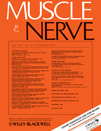Utility of ultrasound-guided surface electrode placement in lateral femoral cutaneous nerve conduction studies
Abstract
Introduction: Meralgia paresthetica is a common clinical complaint for which some patients ultimately undergo surgical treatment. The lateral femoral cutaneous nerve (LFCN) has been difficult to reliably test electrophysiologically, likely due to anatomic variability and lack of responses in asymptomatic obese subjects. Methods: We compared a novel ultrasound-guided antidromic sensory nerve conduction study (NCS) with a technique described previously in a population of normal subjects, of whom 50% had body mass indices within the obese range (>27.5). Results: Responses were obtained in at least 92% of subjects using either technique, and 92% of normal subjects had <60% interside variability using the ultrasound-guided technique. Conclusions: LFCN sensory nerve action potentials can be obtained in the vast majority of normal subjects, even in an obese population and can provide a useful sensory NCS for evaluation of mid-lumbar radiculopathy, plexopathy, or meralgia paresthetica. Muscle Nerve, 2011




